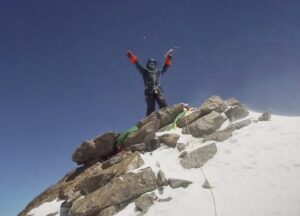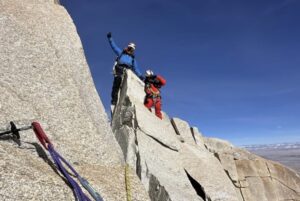For Marek Holecek and Radoslav Groh, it only took a mental snapshot of Baruntse in the Khumbu to launch one of 2021’s most harrowing expeditions.
The two Czech climbers arrived at the peak for a first ascent bid in May. Holecek had spotted the 7,129m mountain’s ice-gripped, 1,800m Northwest Face two years before, during an ascent that would win him a Piolet d’Or.

Marek Holecek (left) and Radoslav Groh. From the climbers’ FB pages. Compilation @KrisAnnapurna
In the end, his and Groh’s bold line required nine days. They returned to the ground in ragged condition — their weather window had slammed shut on day four.
Slow progress, bad terrain, and ‘death’ rockfall
The two climbers had left Base Camp on May 21, at the start of what would be a marginal period of good weather. They hoped that they could briskly execute what would become Heavenly Trap (ABO, M6, VI+, 80°). But they soon ran into dangerous terrain that forced arduous climbing.
Because of a few dry years in a row, Holecek and Groh found dramatically less snow and ice on the face than they expected. This made for slow progress. Problems and dangers compounded.
“Due to the complexity of the terrain, our progress could not be accelerated,” Holecek wrote. “On the contrary, more and more difficult sections were added. With the rising day sun and temperature, stone projectiles began to fly around us, carrying death.”
Cyclone Yaas traps Holecek and Groh high on Baruntse
The slow climbing continued most of the way up. Unconsolidated snow and hideous bivouacs persisted.
If the climbing had been grim all along, it turned dire on May 24. Holecek and Groh had almost gained the Baruntse ridgeline when Cyclone Yaas hammered them, halting progress.

Baruntse, obscured by Cyclone Yaas. Photo: Marek Holecek’s BC team
“In the morning, we had the most difficult passage of the ascent,” Holecek wrote. “Above our head, we have a 250m barrier of broken rock. It takes us a while to decide where our steps will lead. The ascent began to slow down, and the weather broke down.”
Shortly, the bad weather and slow climbing forced a bivy. Holecek and Groh hunkered down on an unlikely outcrop just big enough for their tent and got inside amid snow rivers that persisted all night.
Trapped, frozen, and soaked for days
In a word, Cyclone Yaas was destructive. Categorized as “Very Severe” by the Indian Meteorological Society, it caused $2.76 billion in damages in West Bengal, where it made landfall. Holecek and Groh would almost pay the so-called ultimate price.
Despite the heavy snow and uncomfortable bivy, the two climbers summited Baruntse on May 25. “The weather is bad,” Holecek conceded, “but there is no other way than to climb the ridge, then the top, and go down the classic way. We reach the top around 4 pm, completely frozen, and we can’t see the step due to the fog.”
Their only option was to bivy; whether they saw it coming or not, the cyclone trapped them for the next three days. Though stoic, Holecek’s description of the situation is alarming.
“The weather is devilish and even ordinary basic tasks, such as boiling water or going to urinate, are on the limits of survival,” he wrote. Snow constantly threatened to collapse their tent, forcing more work. “We free the tent from the grip of the snow several times. We wait on the spot and pray. There is nothing more you can do. We already have everything wet, frozen, and we are cold.”

The view of neighboring peaks Everest, Lhotse, and Nuptse on May 27. Photo: Everest Weather Station
Down at base camp, Pavel Hodek and cameraman Tomas Galasek received the climbers’ reports. Obviously, there was nothing they could do — getting up Baruntse in a hurricane is a non-proposition. The only course of action was to “wait for a miracle”, as one report said. Hopefully, said miracle would arrive in the form of improved weather.
The window cracks open
By May 29, Holecek and Groh had made zero progress for four days. They simply waited patiently at the bivy, avoiding panic.
The team at Base Camp explained the extent of the weather. “It snows heavily, 20-30cm of snow daily. Visibility is zero, even in BC. Nobody can get here or [escape] from here. Everybody is waiting for better weather, which should come on Saturday. Thanks again to everyone who keeps their fingers crossed for the boys.”
As prayed for, the “miracle” did arrive on Saturday.
The wind didn’t entirely dissipate, but it did back off enough to facilitate some visibility on the peak. Holecek and Groh jumped at the opportunity. “[T]he progress is slow,” the report reads, “because of the amount of new snow and the risk of avalanches. We descend more than 1,000m along a sharp ridge that leads into the valley.”
By afternoon, it became clear that safety would elude the two climbers for at least one more night. An enormous glacier guards the foot of the Baruntse descent route — Holecek and Groh needed another day of good weather to cross it.
“Another unpleasant bivouac awaits us,” they reported.
Out of the ‘ice hell’ and down from Baruntse at last
But May 30 dawned bright and clear. Cyclone Yaas had dissipated on the 28th. With the worst of the weather over, the climbers called in a helicopter. The decision appeared soundly justified. The day before, Hodek and Galasek reported that snow had made the usual descent route down from Base Camp impossible.
They had held out as long as they could. Nepal’s Home Ministry had already asked all climbers and expeditions to withdraw from the Khumbu.
“The reasons were clear,” Holecek wrote. “No one in BC was waiting for us. There was a lot of new snow on the slopes and in the valley, which was constantly falling down. Neither of us wanted to push ourselves with avalanches after those days.”
Fortunately, search and rescue operators heard their call. At 7 am, rescuers freed the climbers from what they called an “ice hell.” Half an hour later, they sat safely in Lukla.

Relieved. File photo
At that point, Holecek’s report cuts off. “The End,” it says simply. The climbers dedicated Heavenly Trap to Petr Machold and Kuba Vanek, two friends who disappeared on the Northwest Face of Baruntse in 2013.
Holecek, who won his Piolet d’Or for his and Zdenek Hak’s first ascent on Chamlang, holds Heavenly Trap in even higher regard.
“I can say for myself that I have not yet done a harder climb in the mountains,” he said. “I would like to thank my partner [Groh] and the Almighty for their patience.”






